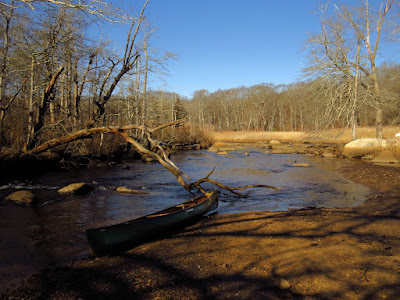Morning was dark and overcast, pretty much what the weather service predicted. Although the day was quite warm for January, it still managed to look kind of grim. But then, the clouds went away in a matter of a few minutes and my ambition took a turn.
I put in at the bottom of Salmon Cove. There is only one other person there and we talk for awhile as is the custom in Connecticut, once you are outside the ring around New York City. He is an amateur photographer and asks if he can photograph me as I paddle away. He also asks about the Osprey nest that seems to have blown down recently and I give him the run down on how they reacted to the wind storm that blew their nests down a few years ago. Then, I head off.
It is calm and the water is near mirror smooth, and it is mirror smooth anywhere that there is the least amount of shelter from an imaginary wind.by the time I reach the first bend, I'm up 2 smallish Hawks, a Great Blue Heron, a pair of Mute Swans, and a mix of about 50 Mallards and Black Ducks. If it quacks like a Duck, then it is not just a Duck - it is either a Mallard or a Black Duck. Other Ducks, if they make any call, do things like wheezing, murmuring, nasally whistles - stuff most people don't expect from Ducks. There is a mature Bald Eagle perched in the outside corner of the bend. I give it wide berth and it stays put.
 |
| Coyote Point |
I have counted over 130 Swans in the cove, but today I spot just eight, in widely scattered pairs. With our mild winter, I suppose they have stayed in smaller water that would have normally frozen over. As I near Coyote Point, ten Swans fly out of from the river and head down the cove. There are a few more up in the river, so the total is about twenty.
The light is quite amazing, I must say. The water is clear, so much so that two and half feet of water looks like it is about six inches deep.
Once in the river, I find a flock of Common Mergansers, mostly males and numbering a dozen or so. I find a few beaver peeled sticks on the shore - always good to see. Beaver eat the inner bark of trees and leave peeled branches with obvious teeth marks. Fifty Canada Geese, that are well ahead, take off.
I start picking up some current as I pass Steam Shovel Junction - a hint that there is a good amount of water coming over the Leesville Dam. Just below the Leesville bridge, something slips off the bank and dives. I saw the water, but not the beast. Could be either a beaver or a muskrat. I slide over to the bank but there are too many leaves on the bank to leave a track. There is a small leafy ring up on some dry sand - just the kind of thing you might imagine to be an animal easy chair. There are a few beaver peels about fifteen feet upstream. Anyway, no sighting, so I move on.
I beat the current up to the dam. There is water coming over for the full width, Usually, most of the water flow comes through the fish ladder. The river is high.
I have pretty much convinced myself that the mammal sighting was a muskrat. And, as I pass the spot, there sits a beaver, sunning itself. It slips off the bank again, but this time it swims lazy circles watching me with its poor eyesight.
I put away the wildlife counter and paddle steady on the way out. It's a beautiful day.

















